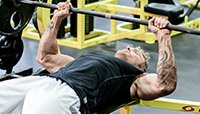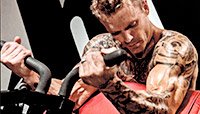

I’m single by choice. No, we’re not talking about my marital status. I’m referring to the fact that I don’t have a workout partner.
Sure, I was hitched in the past, but finding someone who shares my training goals, my degree of commitment, my level of ability (who wants to be pulling off a dozen wheels on the leg press between every set, and then putting them back on?), and the hours I prefer to train isn’t easy.
So the only rings I’ve got are the collars I put on the end of the barbell—and I do that myself.
The downside is that I find it harder to push myself. It’s nearly impossible to get those extra reps when there’s no one behind you barking words of encouragement. Little wonder many of my sets end up a little short of muscle failure.
Importance Of Muscle Failure
Why is that bad? Because training to muscle failure is an important aspect of building muscle. That’s why, even though a muscle that feels like it’s on fire is uncomfortable, successful bodybuilders learn to embrace that pain. After all, beyond the burn is where real gains lie. Hence the bodybuilding mantra: “No pain, no gain”.
Moreover, evidence points toward selectively training past the point at which you can’t do any more on your own. While science shows that taking every set past failure is counterproductive, taking 1-2 sets of each movement past failure can lead to serious gains. This enables you to more thoroughly damage the muscle fibers. This means that, given rest and good nutritional practices, they have a better chance to repair themselves and grow larger.
You might think you need a training partner to go beyond failure, but actually, you don’t! There are a number of training strategies to push past failure on your own. Try these three on for size.
1 Rest-Pause
This technique takes advantage of the muscle fibers’ ability to quickly replenish the energy substrates that power muscle contractions. So instead of doing a heavy set of 7-8 reps and racking the weight because you can’t do any more, with rest-pause you take that same weight and break it into segments interrupted by several 20-second breaks, which allow for those intra-muscular energy systems to quickly restock.
Here you might do just 3-4 reps and take a 20-second rest and do another 3-4 reps, alternating work/rest segments until you’ve completed a total of 4-5 work segments. At the end of the full set, you’ve done 12-20 total reps—a much greater amount of work than had you done just the 7-8 reps without the breaks. The boost in intensity causes additional muscle fiber break down and helps spur muscle-building hormones that promote hypertrophy.

“Instead of doing a heavy set of 7-8 reps and racking the weight, with rest-pause you take that same weight and break it into segments interrupted by several 20-second breaks.”
In Your Workout: Do this intensity booster early in a session, before your strength levels wane. Typically, you should choose a weight that you can do for 7-8 reps (but actually doing only 3-4). Alternatively, you could choose a lighter or heavier weight and adjust the rep targets. So you might use a weight than you can do for 12 reps (your 12RM weight) but string together segments of 6-7 reps, punctuated with 20-second rest intervals.
Best Exercise Choices: Your best exercise choices are multijoint moves that don’t require a great deal of effort to get into and out of position and with which the weight can be easily racked and unracked. Hence machine chest or shoulder presses are better than dumbbell presses for those body parts. The Smith machine in particular can work really well here.
2 Partial Reps

“By restricting the movement to just the top half of the ROM, you’re above the sticking point and are capable of completing a few more reps with a given weight.”
Typically, you take a rep through its entire range of motion, from the muscle’s fully stretched position to its fully contracted one. Ultimately, a set ends when you hit what’s called the sticking point; the biomechanics are such that you’re in the weakest position leverage-wise as fatigue sets in. For most of us, that’s somewhere near the middle of the movement arc.
With partials you’re focusing on only a portion of that range of motion (ROM). For example, once you reach muscle failure, by restricting the movement to just the top half of the ROM, you’re above the sticking point and are capable of completing a few more reps with a given weight. Hence you’re able to subject the fibers to a higher degree of intensity than what they’re normally accustomed to.
Let’s say lying leg curls with 120 pounds yields eight reps, and you can’t do any more on your own. Don’t give up! From the fully contracted position, lower the weight halfway down and contract the muscle again. Continue doing as many reps as you can over this partial ROM.
In Your Workout: Do this on the last set or two of a given exercise. Because it fatigues a muscle more than had you ended the set when you reached full-ROM failure, it affects your strength on successive sets and exercises.
Best Exercise Choices: Movements in which you can safely train past muscle failure over a shortened ROM. For the most part, that’s machine movements.
3 Dropsets
Not counting warm-ups, it’s likely that you take just about every set close to muscle failure. Now, instead of racking the weight or putting the bar down, immediately reduce the poundage by 20-30% of the total weight and continue on with your set until you reach a second point of muscle failure. You can even repeat this a third time.
Besides burning more calories, this technique recruits additional motor units to engage the maximal number of muscle fibers as possible during a set. At the end of your workout, dropsets can also help you engorge the muscle with additional fluids that help stretch the the encasing around the muscle, called fascia, and promote the release of muscle-building hormones. Dropsets are also known as strip sets.

Pin-loaded machines and cables are your best choice for dropsets as they allow for rapid weight changes.
In Your Workout: This technique should be used on your last 1-2 sets of a given exercise or during the later stages of your workout. The increased degree of fatigue can adversely affect your strength levels on your remaining sets, so it’s not necessarily good to use early in your workout when training for strength.
Keep your rest periods as short as possible to ensure that the lighter weight doesn’t become an altogether different set. Changing plates and then getting set back into position—especially when training alone–lengthens the rest interval, so having the weights you need handy makes sense.
Best Exercise Choices: Pin-loaded machines (changing the weight is as easy and pulling and re-inserting the pin) and cables. With dumbbells, have a second pair nearby. When using a barbell or plate-loaded machines, use smaller plates on the ends so making a weight change is fast.
Recommended For You

6 Mistakes That Are Killing Your Gains
Taking the next step in muscular development is partially about training better, but it’s just as much about removing the roadblocks to anabolism that hold you back. Are you committing any of these crimes?

Can Machines Build Enough Muscle?
If you’re looking to add muscle, machine training can help—but only to a certain degree. Here’s how and when to use machines for gains.

The No. 1 Reason You’re Not Growing
Just showing up and lifting isn’t going to maximize your muscle and strength gains. Here’s how to implement the most critical principle of bodybuilding: progressive overload.
Continue at source:























